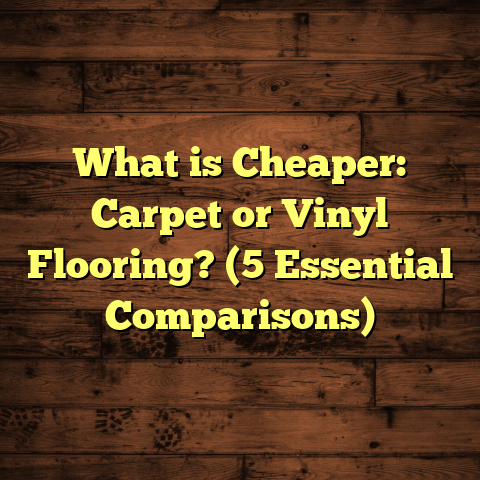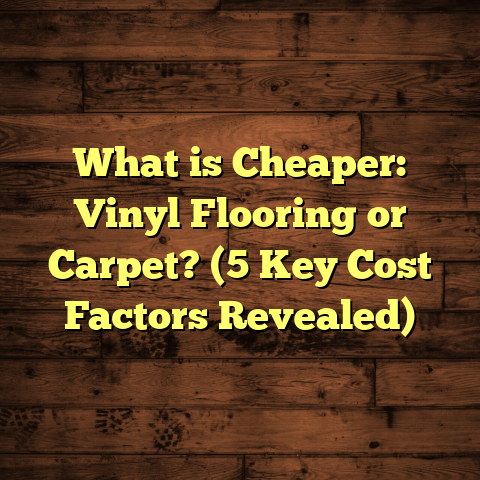What is Marvel Flooring Cost? (5 Factors That Affect Pricing)
I want to start by saying that trying to get a handle on flooring costs can be one of the most frustrating experiences if you’re not prepared. I remember when I first started working with Marvel flooring, the estimates kept shifting. One minute I thought I had a solid budget, and the next, the numbers ballooned due to factors I hadn’t fully considered. It’s easy to feel overwhelmed when you’re staring at a project and wondering where all these extra costs are coming from.
If you’re thinking about Marvel flooring or already have it on your radar, understanding the true cost is going to save you time, stress, and money. So, let’s get into it.
What Is Marvel Flooring Cost?
When people ask me, “What is Marvel flooring cost?” they usually mean, “How much will it actually cost me to get Marvel flooring installed in my home or business?” This includes everything — not just the price tag on the box but the full package.
Marvel flooring is a brand that encompasses several types of flooring materials—vinyl planks, engineered hardwood, laminate, and sometimes tile options. Each has different price points depending on quality, thickness, finish, and other characteristics.
When I talk about Marvel flooring cost, I’m referring to the total cost of purchasing the material plus installation expenses and any additional preparation or finishing work involved. This is critical because many people make the mistake of budgeting based solely on material cost and get caught off guard when labor and prep add up.
In essence: Marvel flooring cost = Material + Labor + Preparation + Extras + Waste.
If you’re shopping around or trying to plan your renovation budget, breaking down these components will give you a clearer picture.
Why the Confusion Around Cost?
Marvel flooring isn’t like buying a T-shirt where you see a fixed price on a shelf. Prices can shift dramatically based on your location, installation complexity, and product choice. Plus, the brand offers several product lines with different features—like waterproof options or enhanced wear layers—which come at different price points.
I’ve seen customers shocked when they thought they were buying “standard” Marvel vinyl plank but ended up with premium-grade planks because of the showroom’s recommendations. Those extra features can add 30-40% to material costs alone.
So, let’s break down the main factors that influence Marvel flooring cost more precisely.
The 5 Factors That Affect Marvel Flooring Pricing
1. Material Quality and Type
This is probably the biggest variable in your overall cost.
Marvel flooring covers several product types:
- Vinyl Plank Flooring: Often durable, waterproof, and budget-friendly. Prices can start around $2.50 per square foot for standard quality and go up to $7 or more for premium options.
- Engineered Hardwood: This combines real hardwood veneer over plywood layers. It offers authentic wood looks but costs more—usually between $5 and $12 per square foot.
- Laminate Flooring: A cost-effective alternative mimicking wood or stone appearance but made of composite materials. Prices hover between $2 and $6 per square foot.
- Tile Options: Sometimes included in Marvel’s offerings as luxury vinyl tile (LVT) or ceramic tile. Tiles can be pricier depending on design and durability.
Within each category, you’ll find different grades:
- Standard Grade: Basic durability, fewer design options.
- Mid-Grade: Better finishes, improved wear resistance.
- Premium Grade: Top-tier durability, advanced water resistance, realistic textures.
When I work with clients, I always encourage them to think about how much traffic the floor will see. For example, if you have kids or pets running around, opting for premium-grade vinyl plank can save money long-term by reducing scratches and wear repairs.
In one project last year, a client initially chose standard vinyl for a playroom but switched to premium after seeing samples. The cost difference was about $1.50 per square foot but gave them peace of mind and better warranty coverage.
Data Point:
According to industry reports, vinyl plank flooring costs average around $3.50 per sq ft nationally, but premium lines like Marvel’s waterproof collections can push that to $5-$7 per sq ft depending on features.
2. Installation Complexity
This is where many homeowners are surprised by the final bill.
Some floors are simple to install—flat surfaces, straightforward patterns, no obstacles. Others require intricate cuts around corners, staircases, or built-in cabinets. Some subfloors might need repairs or leveling before installation can begin.
I once had a client with an old Victorian house where the wooden subfloor was uneven by almost half an inch in places. We had to spend extra time leveling and repairing before laying down Marvel laminate flooring. The added labor nearly doubled the original installation quote.
Installation labor costs typically range from $3 to $8 per square foot depending on:
- Surface preparation needed
- Pattern complexity (e.g., herringbone is costlier than straight planks)
- Room shape and number of doorways
- Removal of old flooring
For example, a simple rectangular room with smooth concrete subfloor might cost $3/sq ft to install vinyl plank. But a large kitchen with multiple angles and tile backsplash could push labor up to $7 or $8/sq ft.
3. Geographic Location and Labor Rates
Where you live makes a big difference in costs.
Labor rates vary widely across cities and states based on local economies and demand for contractors. In metropolitan areas with higher living costs—think New York City, San Francisco—expect labor charges near the top end of ranges ($6-$8 per sq ft).
In smaller towns or rural areas, labor rates for installing Marvel flooring might be closer to $3-$4 per sq ft.
Material availability also affects pricing. If Marvel products have to be shipped longer distances or imported specially for your region, prices might increase slightly.
One time I bid on a job in Alaska where shipping materials pushed material cost up by 10%. Labor was also higher due to limited local contractors experienced with Marvel products.
4. Project Size and Scope
It’s tempting to think bigger always means more expensive—but there’s nuance here.
Large projects often benefit from economies of scale:
- Contractors may offer volume discounts on materials.
- Installation crews can work more efficiently over larger continuous areas.
- Less overhead per square foot as setup time spreads out.
In commercial jobs exceeding 2,000 sq ft of Marvel flooring, I’ve seen material discounts up to 15% off list price. Labor can also be negotiated down slightly for bulk work.
Smaller projects sometimes carry minimum service fees or surcharges that make their per-square-foot cost higher.
For homeowners doing small renovations (e.g., 100–200 sq ft), expect to pay more per square foot than large-scale projects due to fixed labor minimums.
5. Waste Factor and Additional Materials
This is one factor that often slips under the radar.
You won’t use every square foot of flooring material you buy because cuts and mistakes create waste. Typically, professionals recommend ordering an extra 5-10% material over your actual floor area to cover this.
Additionally:
- Adhesives or glue (if required)
- Underlayment (for moisture barriers or soundproofing)
- Transition strips between rooms
- Baseboards or quarter round trims
All these add to your final costs.
In one job where I installed Marvel vinyl plank in an irregularly shaped basement with many corners and stairs, we ordered an 8% waste factor but still ran short due to unexpected cuts around vents. This added another delivery charge and delayed completion.
Extra materials alone added about $0.75 per square foot beyond initial estimates.
The Real Cost Breakdown: Putting It All Together With Examples
Let me paint a scenario based on some of my recent projects so you can visualize how these factors interact:
Scenario 1: Mid-Range Home Office Installation
- Area: 350 sq ft
- Material: Marvel Mid-Grade Vinyl Plank @ $4/sq ft
- Labor: Standard installation @ $4/sq ft
- Prep: Minimal (floor clean & dry)
- Waste: 7% allowance
- Extras: Underlayment & transition strips @ $0.75/sq ft
Calculations:
| Item | Rate ($/sq ft) | Quantity | Total Cost ($) |
|---|---|---|---|
| Material | 4 | 350 sq ft | 1,400 |
| Labor | 4 | 350 sq ft | 1,400 |
| Waste (7%) | 0.28 (7% of 4) | 24.5 sq ft | 98 |
| Extras (underlayment) | 0.75 | 350 sq ft | 262.50 |
| Total | 3,160.50 |
This aligns well with what I quoted clients in similar situations—a solid mid-range job without surprises.
Scenario 2: Premium Kitchen Remodel With Complex Layout
- Area: 600 sq ft
- Material: Premium Marvel Engineered Hardwood @ $9/sq ft
- Labor: Complex installation with cuts @ $7/sq ft
- Prep: Subfloor leveling @ $1.50/sq ft
- Waste: 10%
- Extras: Trim & adhesives @ $1/sq ft
Calculations:
| Item | Rate ($/sq ft) | Quantity | Total Cost ($) |
|---|---|---|---|
| Material | 9 | 600 sq ft | 5,400 |
| Labor | 7 | 600 sq ft | 4,200 |
| Prep | 1.5 | 600 sq ft | 900 |
| Waste (10%) | 0.9 (10% of 9) | 60 sq ft | 540 |
| Extras | 1 | 600 sq ft | 600 |
| Total | 11,640 |
That’s a hefty investment but reflects real costs I’ve encountered in upscale remodels with high-end Marvel products.
How I Use Data Tools Like FloorTally for Accurate Estimates
Over time, I’ve learned that eyeballing costs or relying on rough guesses leads to mistakes. That’s why I use tools like FloorTally during consultations and planning phases.
FloorTally lets me input exact room dimensions, choose specific Marvel products from their database, and factor in local labor rates automatically. It even adds waste allowances so estimates are realistic.
This tool saved me hours of back-and-forth while quoting jobs and helped clients feel confident about their budgets before committing.
If you want precise numbers tailored for your project location and size without guesswork, FloorTally is worth checking out.
Real-Life Case Study: Saving Money Without Sacrificing Quality
A few months ago, I worked with a couple renovating their rental property who wanted Marvel vinyl plank floors throughout four apartments totaling about 1,200 square feet each.
They were hesitant about expensive material but wanted durability since tenants change frequently.
After analyzing their needs:
- We chose a mid-grade waterproof Marvel vinyl plank.
- Adjusted layout for minimal waste.
- Scheduled installations in batches for labor efficiency.
- They received a bulk material discount of about 12%.
Final cost was approximately $4/sq ft installed — well below typical market rates for similar quality floors in that region.
They were thrilled because it increased property value without breaking the bank.
FAQs About Marvel Flooring Cost From My Experience
Q: How long does Marvel flooring last relative to its cost?
A: When installed properly and maintained well, premium-grade Marvel flooring can last upwards of 15-20 years — excellent value over time compared to cheaper alternatives needing replacement every few years.
Q: Are there hidden fees contractors don’t tell you about?
A: Sometimes yes—things like disposal of old flooring or unexpected subfloor repairs might not be included upfront unless clarified in writing.
Q: Can budget-friendly Marvel products still look stylish?
A: Absolutely! Even entry-level options come in various textures and patterns that can modernize rooms without costing a fortune.
Q: Is it worth hiring professionals for installation?
A: Unless you’re very confident with tools and techniques—and your floor layout is simple—I strongly recommend professionals to avoid costly mistakes.
Wrapping Up My Insights on Marvel Flooring Cost
Having worked hands-on with dozens of projects featuring Marvel flooring over several years, I can say the key to managing costs lies in understanding what goes into your final bill—not just what’s printed on product tags.
Material choice is just the start; installation complexity, location-based labor rates, project scale, waste factors, plus extras all play crucial roles in shaping total expenses.
If you’re planning your own project:
- Get detailed quotes breaking down each element.
- Consider long-term durability alongside upfront price.
- Use online tools like FloorTally for personalized cost projections.
- Don’t hesitate to ask questions about what’s included or extra.
- Budget an allowance for unexpected issues—old homes tend to surprise even the best contractors!
I hope this deep look at Marvel flooring cost helps you avoid pitfalls and make smarter decisions for your space. If you want help estimating costs tailored exactly to your project specifics or need advice on product selection and installation options, just ask—I’m happy to share what I’ve learned from years in the field!





